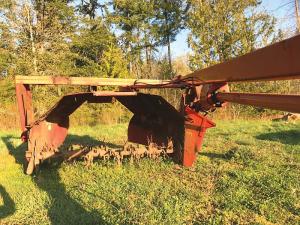2021 - Volume #45, Issue #4, Page #31
[ Sample Stories From This Issue | List of All Stories In This Issue | Print this story
| Read this issue]
Mower Conditioner Converted Into Low-Cost Compost Turner
 |
“I got the idea from an article in FARM SHOW, ‘Low-Cost Compost Turner Great For Small Farmers’ (Vol. 44, No. 2),” says Wyndlow. “My dad and his twin brother had assembled a stockpile of parts from various machines, and I was fortunate to inherit the inventory. We had a salvaged Taarup gearbox from a 6-ft. wide mower in inventory, and I was delighted to finally justify having kept it.”
Wyndlow removed the rotary cutter head completely and dropped the rear conditioner flair bar to where the cutter head had been. He also replaced the damaged angle gearbox, reduced the speed, and increased torque with other modifications.
“I swapped out the high-speed sprockets for the lowest combination I could find in our inventory,” says Wyndlow. “I thanked the spirit of my dad for the large wooden box of gears, bearings, sprockets and chain.”
Wyndlow noticed that most compost turners had fairly large paddles arranged in a corkscrew pattern on the mixing shaft. He knew this design was key to drawing material in from the edges and toward the center. Eager to get the turner operational before fall rains, he opted to use the forked tines already on the conditioner flair bar.
“I cut off and repositioned about 20 of the tines to produce a similar effect of bunching material toward the center,” says Wyndlow.
He then reshaped the existing steel cowling from the mower and some leftover 1/8-in. steel fairings to fit the machine’s new purpose.
As he pulled the new turner into the compostables, he discovered that even running his 80-hp. tractor at an idle was too fast. Riding the clutch slowed the speed down just enough.
“It does a terrific job of mixing and aerating the windrow,” says Wyndlow. “I can straddle and mix a 4-ft. high, 8-ft. wide and 200-ft. long row in about 5 to 6 minutes.”
Wyndlow says the turner did tend to flatten the windrow and spread it out to about 9 to 10 ft. wide. He modified the cowling at the rear to help direct material into a narrower windrow. He also runs a front-end loader down the row to trim the sides back to about 7 ft. wide.
“I think bigger paddles at a lower speed will be the ultimate answer,” says Wyndlow. “However, I figure it is achieving about 90 percent of the job I had hoped for and doing it quicker than blending materials with the front-end-loader.”
Contact: FARM SHOW Followup, Ian Wyndlow, 13188 Doole Rd., Ladysmith, B.C. Canada V9G 1G6 (ph 215 619-9760; ian@liquidstonestudios.com).

Click here to download page story appeared in.

Click here to read entire issue
To read the rest of this story, download this issue below or click here to register with your account number.




